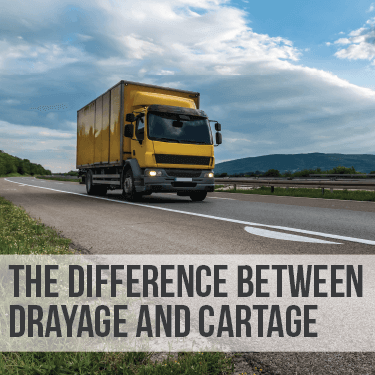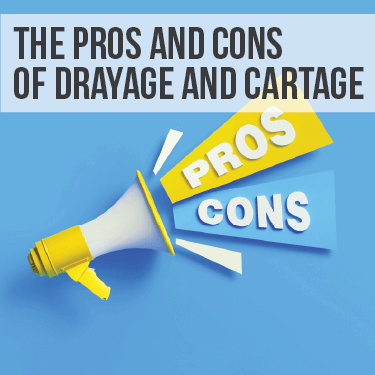As businesses seek to find the most efficient methods of moving their freight, the debate of whether to use drayage vs cartage continues. While each of these services fulfills similar goals throughout the supply chain, the manner in which they do so differs.
Drayage vs. cartage — the former is a short connecting trip used to move a container from a port of entry to another nearby facility, while the latter is used by breaking down the contents of a container to load said cargo onto outgoing trucks for distribution to several different locations within a targeted area.
Read on to learn more about the differences between drayage and cartage, including the advantages and disadvantages of each.

The major difference between drayage and cartage is the manner in which the shipping containers are handled once they’re received at the port. To get a better picture of each of these services, let’s define them.
Drayage services are used for short and efficient hauls. A chassis truck — a special flatbed that shipping containers are loaded directly onto — will drive to the port and pick up the freight in question. From there, the freight will be hauled a short distance (no more than 250 miles, but often much shorter) to either a warehouse or a distribution center.
Once the freight arrives at one of these supply chain checkpoints, the drayage service is completed. While it’s not a hard-and-fast rule, it’s often considered that any journey the freight makes following drayage is just a normal freight shipment.
Cartage refers to the process of a container being received, then opened and dispersed into smaller containers or trucks. These multiple, smaller shipments are then typically delivered around a city or larger metropolitan area. Cartage can be used as either a freight shipment or as a connecting movement within a supply chain.
These are also considered less-than-truckload (LTL) shipments since they likely won’t fill an entire truckload once the container contents are distributed among several vehicles. Depending on the breakdown of the freight, 18-wheelers, box trucks or even vans can be used for cartage.
In summation, the largest difference between the two services is that drayage moves an entire container a short distance so that it can continue on its journey, while cartage breaks a container shipment down into multiple loads to be transported.

Drayage and cartage are both important steps along the supply chain. While their methods may be different, they are both used to move goods over short distances, moving products from their port of entry, to their next destination.
In order to properly explain the benefits of cartage services, let’s take a look at an example of how it’s used.
Cook County in Illinois has over 5 million residents and is home to Chicago, America’s third-most populous city. Chicago and its many suburbs dominate Cook County, making it a logistical challenge to distribute all of the goods that its residents purchase throughout the area.
By using cartage services, you can haul a shipping container to a distribution center, warehouse or transload facility, and then load its contents onto several different trucks that will each deliver to different parts of the county. Cartage is great for large, heavily-populated metropolitan areas.
On the flip side, cartage has two minor drawbacks — one of which can be easily navigated, while the other is simply a fact of the matter.
Container drayage, as previously noted, is advantageous under normal circumstances. However, considering the current issues plaguing the global supply chain, its role has increased immensely. By definition, drayage serves as a link between short distances as part of a much larger freight movement. This helps move freight out of the port - eliminating congestion - and to a nearby location that can point each of the goods in the right direction.
Another benefit of drayage, at least relative to cartage, is that freight is handled much less. In fact, the freight inside the container likely won’t be handled at all from the time it’s loaded onto its ocean vessel to the point that it arrives at its final destination. The less freight is handled, the less likely it is to get damaged.
One disadvantage of drayage is that because the full container is hauled - not the individual products - the internal contents of said containers can’t be broken down and redistributed in the way that transloading or cartage services can do. So if you need your freight moving in different directions, drayage wouldn’t suit your needs.
Whichever you decide in the drayage vs. cartage decision, you need someone who can perform these services to the best of their ability. That’s why partnering with USA Truckload Shipping to carry out drayage or cartage as a trusted 3PL provider is a prudent decision that can give a boost to your freight transportation and shipping.
USA Truckload Shipping, powered by R+L Global Logistics, has the access to chassis capacity needed for both drayage and sometimes cartage, so you’re hopefully never sitting around waiting for your freight to be moved out of the port and racking up sky-high demurrage charges.
Besides drayage and cartage, R+L Global Logistics can carry out any kind of freight shipping you require. This includes, but is not limited to:
So whether you need a truck, a warehouse, or any other supply chain services while you’re making the choice between drayage vs. cartage, make sure to call the industry experts at R+L Global Logistics at (866) 353-7178 for a no-hassle freight quote.
R+L Global Logistics
315 NE 14th St., Ocala, FL 34470